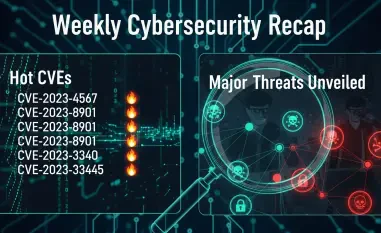Ransomware has undergone a significant transformation since its inception in the late 1980s. From rudimentary beginnings to sophisticated, financially motivated attacks, the evolution of ransomware reflects broader changes in technology and cybercrime. This article delves into the history and development of ransomware, highlighting key milestones and the ever-changing tactics employed by cybercriminals.
The Birth of Ransomware: The AIDS Trojan
The Inception of the AIDS Trojan
In December 1989, the computer world saw the introduction of its first ransomware locker, the AIDS Trojan, created by Joseph Popp, an anthropologist and biologist with a background at Harvard University. Popp’s mental breakdown, likely influenced by professional setbacks, catalyzed the creation of this novel malware. The AIDS Trojan was a groundbreaking cyber threat, especially for a time when the internet and cyber infrastructure were not as developed as they are today. This early form of ransomware operated by modifying the AUTOEXEC.bat file, tracking the computer’s boot cycles until reaching 90, at which point it would hide directories and encrypt the C drive’s file names, rendering the system unusable without decryption.
Popp’s motive appeared to be driven by personal grievances rather than financial gain. His bizarre behavior following his arrest, such as wearing condoms on his nose and hair curlers in his beard, led a British judge to rule him mentally unfit to stand trial. Popp’s creation, while technically simple compared to today’s standards, was innovative for its time, introducing the world to the concept of encrypting data as a ransom tactic. He later retreated from the public eye, establishing a butterfly sanctuary in upstate New York until his death in 2007. This novel malware revealed a new realm of cyber threats, making it a historical landmark in cybersecurity.
Early Distribution and Impact
The AIDS Trojan was disseminated via an unusual but effective method: 20,000 floppy disks were sent to attendees of a WHO AIDS conference, demonstrating an early form of what would later be recognized as phishing lures. Victims were instructed to send 9 to a PO Box in Panama to regain access to their files, a ransom amount that would be approximately 0 or £378 today. This initial attack was not only a technological innovation but also showcased an early understanding of social engineering tactics to distribute malware.
Despite its groundbreaking nature, the attack garnered minimal public attention at the time. The lack of modern internet infrastructure and widespread use of hard disk drives meant that the impact was relatively contained. Moreover, cybersecurity measures were essentially non-existent outside of highly secure environments like the military. Consequently, while the AIDS Trojan set the stage for future developments in ransomware, it did so in a manner that only hinted at the significant threats that would evolve in the coming decades.
The Resurgence of Ransomware in the Mid-1990s
Academic Exploration and Cryptography
The mid-1990s marked a crucial period in the evolution of ransomware as academics began to explore the possibilities of combining malware functionality with cryptographic techniques. Researchers delved into the potential of encryption as a method to monetize cyber attacks, effectively laying the groundwork for the next generation of ransomware. This academic exploration hinted at the resurgence of ransomware, which had mostly faded from public consciousness since the AIDS Trojan.
This period saw a focus on advancing not just the technical aspects of malware but also the theoretical frameworks that would support more sophisticated attacks. By focusing on cryptography, researchers identified ways to create nearly unbreakable encryption schemes that could substantially increase the effectiveness of ransomware. These early academic efforts were instrumental in setting the stage for future developments, as they provided a roadmap for how malware could evolve from simple disruptive programs to powerful tools for financial gain.
The Emergence of Gpcode
In December 2004, the ransomware landscape was forever changed with the emergence of Gpcode. This particular ransomware marked a significant shift from earlier forms by specifically targeting individual files for encryption and demanding a monetary transfer for their decryption. Unlike its predecessors, Gpcode epitomized the modern ransomware archetype by focusing on economic incentive rather than merely causing disruption. This attack set the stage for the monetization of cyber attacks, albeit through rudimentary means like money transfers, preceding the advent of cryptocurrencies that would later revolutionize the field.
Despite its basic encryption methods and the usage of traceable monetary transactions, Gpcode was a watershed moment in the history of ransomware. Its relative lack of success underscored the infancy of ransomware awareness, both within cybersecurity circles and the general public. Nevertheless, Gpcode showcased the potential for ransomware to evolve into a serious and organized form of cybercrime, spurring further innovation and strategies in malicious software development. This initial foray into monetized ransomware provided valuable lessons for cybercriminals, who would increasingly look to enhance both the technical and logistical aspects of their operations in the years to come.
The Rise of Organized Cybercrime
The Advent of Cryptocurrencies
Over the subsequent decade, ransomware’s trajectory was one of relentless innovation, driven predominantly by an increasing desire for financial gain and evading capture. One of the core challenges for cybercriminals was ensuring anonymity during ransom payments. Initial attempts involved digital currencies such as E-Gold and Liberty Reserve, which offered some level of anonymity but eventually succumbed to regulatory and law enforcement actions. However, it was the advent of cryptocurrencies, especially Bitcoin, that truly revolutionized the ransomware landscape. Bitcoin provided a solution that facilitated anonymous transactions, thereby mitigating the risk of traceable monetary transfers.
This period marked the beginning of organized cybercrime, as sophisticated methods and technologies became more accessible to criminals. The ability to receive ransom payments anonymously via cryptocurrencies reduced the risk of apprehension, encouraging more cybercriminals to engage in ransomware activities. Additionally, the decentralized nature of cryptocurrencies made it increasingly challenging for law enforcement agencies to track and seize illegal funds. As a result, the ransomware landscape evolved to become more complex and widespread, with financially motivated cybercriminals leveraging new tools and techniques to maximize their gains while minimizing risks.
Ransomware as a Service (RaaS)
Another significant development during this transformative period was the introduction of Ransomware as a Service (RaaS). This model allowed technically adept malicious software developers to partner with criminals who lacked advanced technical skills, thereby expanding the reach and effectiveness of ransomware attacks. RaaS democratized ransomware, making it accessible to a broader range of cybercriminals who could now lease ransomware tools and infrastructure. This business model significantly contributed to the widespread proliferation of ransomware, as it required minimal technical expertise to execute highly effective attacks.
RaaS platforms provided customizable ransomware kits, comprehensive technical support, and even profit-sharing arrangements, making it an attractive option for less-skilled criminals. This commoditization of ransomware not only increased the frequency of attacks but also raised the overall sophistication of the ransomware ecosystem. Cybercriminals could now focus on targeting vulnerable organizations and individuals without needing to develop their own ransomware from scratch. The emergence of RaaS represented a paradigm shift in the ransomware landscape, turning it into a lucrative industry driven by innovation and collaboration among cybercriminals.
Targeting Businesses: The SamSam Ransomware
Shift in Attack Strategies
In 2016, the ransomware landscape witnessed another significant shift with the advent of the SamSam ransomware. Unlike its predecessors, which largely focused on mass-market attacks aimed at a wide audience, SamSam attackers chose to meticulously target businesses. This strategy involved infiltrating networks, identifying crucial servers, and deploying ransomware in a calculated manner to maximize disruption and potential ransom amounts. By focusing on high-value targets, the SamSam attackers underscored the escalating financial stakes involved in ransomware attacks and highlighted the sophisticated techniques employed by modern cybercriminals.
The SamSam ransomware attacks were methodical and well-planned, often involving months of reconnaissance work to identify the most valuable assets within an organization’s network. Once inside, the attackers would disable backups and other security measures before deploying the ransomware, ensuring maximum impact. This targeted approach not only increased the likelihood of organizations paying the ransom but also minimized the chances of detection and mitigation before the ransomware could be activated. The SamSam attacks demonstrated the growing complexity of ransomware campaigns and the need for businesses to adopt more robust cybersecurity measures to protect against such sophisticated threats.
Financial and Emotional Impact
While individual end-users continued to face significant emotional and often unrecoverable losses from ransomware attacks, businesses emerged as more lucrative targets for cybercriminals. The financial risks faced by businesses underscored the growing threat of ransomware and the need for comprehensive cybersecurity strategies. The SamSam attacks exemplified the increasing complexity and targeted nature of modern ransomware campaigns, prompting organizations to invest in advanced security measures and incident response plans to mitigate potential damage.
The financial impact of ransomware attacks on businesses can be devastating, with ransom demands often reaching hundreds of thousands or even millions of dollars. In addition to the direct financial losses, businesses also face reputational damage, operational disruptions, and potential legal liabilities. The emotional toll on individuals and employees affected by ransomware attacks can also be significant, as they may experience stress, anxiety, and a sense of violation. The shift towards targeting businesses highlighted the importance of adopting a proactive and holistic approach to cybersecurity, emphasizing the need for vigilance, preparedness, and resilience in the face of evolving cyber threats.
The Modern Ransomware Landscape
Post-2020 Surge in Incidents
The period post-2020 witnessed a remarkable rise in ransomware incidents, garnering significant media attention and highlighting the symbiotic relationship between financially motivated cybercrime and political cyber espionage. This era also saw the proliferation of double extortion techniques, where cybercriminals not only encrypted a victim’s data but also threatened to leak sensitive information if the ransom was not paid. This multi-faceted approach increased the pressure on victims to comply with ransom demands, further complicating the ransomware landscape.
The post-2020 surge in ransomware incidents was facilitated by a burgeoning underground economy that supported the widespread dissemination and execution of ransomware attacks. Cybercriminals could easily access and purchase ransomware tools, exploit kits, and stolen credentials, making it easier than ever to launch sophisticated attacks. The increasing interconnectedness of digital infrastructure and the expanding attack surface also contributed to the rise in incidents, as cybercriminals exploited vulnerabilities in remote work environments, cloud services, and supply chains. This period underscored the critical need for organizations to adopt comprehensive cybersecurity measures, including threat intelligence, endpoint protection, and incident response capabilities, to defend against the relentless onslaught of ransomware attacks.
Emerging Trends and Future Outlook
A recent trend identified in the modern ransomware landscape involves ransomware gangs like BianLian adopting extortion tactics without encryption, representing a potential shift in ransomware strategies. Instead of encrypting data, these attackers threaten to release sensitive information unless a ransom is paid, leveraging the fear of data breaches and reputational damage to extort victims. This evolving method suggests that ransomware as a concept will persist, continually adapting to bypass defenses and exploit new vulnerabilities.
Despite these evolving methods, ransomware’s core objective remains unchanged: financial gain through the coercion of victims. The integration of IT across various sectors will inevitably attract cybercriminal activity, ensuring ransomware’s continuation in potentially altered forms. As cybercriminals continue to innovate and refine their tactics, the need for continuous improvement in cybersecurity practices becomes increasingly critical. Organizations must stay informed about emerging threats, invest in advanced security solutions, and foster a culture of cybersecurity awareness to effectively counter the ever-evolving ransomware landscape.
The Importance of Cybersecurity Awareness
Proactive Measures and Vigilance
As ransomware continues to evolve, the necessity for heightened cybersecurity awareness becomes paramount. Proactive measures and vigilance are essential to counter potential cyber threats and protect valuable data and systems. Organizations must adopt a multi-layered approach to cybersecurity, incorporating preventive measures such as regular software updates, patch management, employee training, and the use of advanced threat detection and response tools. By staying informed about the latest ransomware trends and attack vectors, organizations can better prepare for and mitigate the risks associated with ransomware attacks.
Implementing robust backup and recovery strategies is also crucial in minimizing the impact of ransomware incidents. Regularly backing up critical data and ensuring that backups are secure and easily accessible can help organizations recover quickly in the event of an attack. Additionally, conducting regular security assessments and penetration tests can identify vulnerabilities and weaknesses in the organization’s security posture, allowing for timely remediation and strengthening of defenses. The legacy of constant innovation in ransomware underscores the importance of staying ahead of cybercriminals and safeguarding valuable data and systems through a proactive and vigilant approach to cybersecurity.
The Ever-Advancing Landscape
Ransomware has come a long way since it first appeared in the late 1980s. Initially, these malicious programs were fairly basic, but over time they’ve evolved into highly sophisticated and financially motivated cyber attacks. This transformation mirrors the broader advancements in technology and the changing landscape of cybercrime. Today, ransomware is a major threat, targeting not just personal computers but also large organizations, government agencies, and essential infrastructure.
One of the first known ransomware attacks was the AIDS Trojan, which appeared in 1989. It was quite primitive, demanding a ransom to be sent via postal mail. Fast forward a few decades, and ransomware tactics have become much more advanced. Modern ransomware can encrypt entire networks, demanding payments in untraceable cryptocurrencies like Bitcoin.
Cybercriminals now employ a variety of tactics, including double extortion, where they not only encrypt data but also threaten to leak sensitive information if the ransom isn’t paid. Additionally, the rise of Ransomware-as-a-Service (RaaS) has made it easier for even less skilled hackers to launch attacks, as they can simply rent ransomware tools from more experienced cybercriminals.
Looking at these developments, it’s clear that ransomware is not just a passing threat but a persistent and evolving menace. This article explores the history and evolution of ransomware, detailing key milestones and the ever-changing methods cybercriminals use to exploit their victims.













